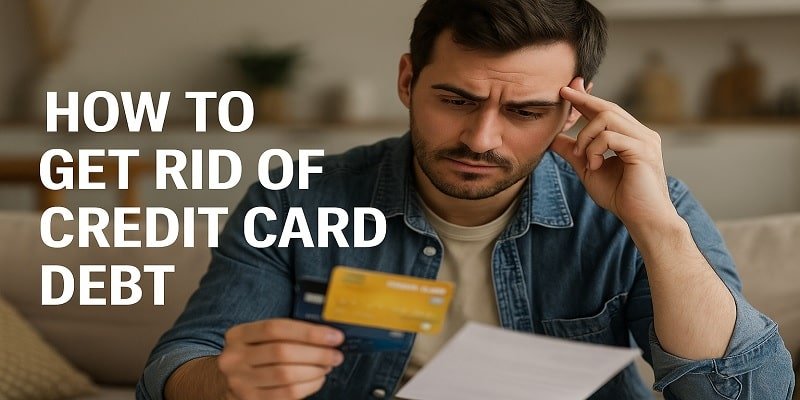“10 Tips on How to Get Out of Credit Card Debt”
How to Get Out of Credit Card Debt: Credit card debt can feel like a heavy burden on your shoulders—high interest rates, minimum payments that barely make a dent, and the constant stress of paying off the debt. If you’re struggling with credit card debt, you’re not alone. The average American has more than $6,000 in credit card debt, and if you don’t take action, that interest can keep you stuck for years.
The good news? You can get out of credit card debt with the right plan. Here are 10 proven tips that will help you pay off your balance faster, save money on interest, and achieve financial freedom.
1. Face your debt head-on (don’t ignore it anymore!)
The first step to getting out of credit card debt is knowing how much you owe. Many people avoid checking their statements because it’s stressful, but denial only makes the situation worse.
What to do:
- Make a list of all your credit cards, balances, interest rates, and minimum payments.
- Use a debt tracker (like this free one from NerdWallet) for a full view.
- Calculate how long it will take to pay it off with minimum payments (spoiler: a lot of time!).
Facing your debt gives you clarity and the motivation to take action.
2. Stop using your credit cards
If you want to get rid of credit card debt completely, stop adding more debt to it. Put your cards away (or freeze them in an ice cube if necessary!) and start using cash or a debit card.
Why it works:
- Stops your balance from growing.
- Forces you to spend only what you have.
Pro tip: If you rely on credit for emergencies, build a small emergency fund of $500-$1,000 first.
3. Choose a debt payoff strategy
Two popular methods can help you tackle credit card debt systematically:
A. Debt snowball method (quick wins!)
- Pay off the smallest amount first and make minimum payments on the rest.
- After paying off the smallest debt, include that payment in the next payment.
- Best suited for: people who need motivation from quick wins.
B. Debt avalanche method (savings on interest!)
- Pay off the highest-interest debt first and make minimum payments on the rest.
- Saves you the most money in interest over time.
- Best suited for: For people who want the most cost-effective method.
Which one should you choose?
- If you need motivation, → Snowball.
- If you want to save money, → Avalanche.
For a more in-depth comparison, check out this guide from The Balance.
4. Negotiate lower interest rates
High interest rates make paying off credit card debt difficult. But guess what? You can ask for a lower interest rate!
How to do it:
Call your credit card company and say:
“I’m trying to pay off my debt, but the high interest is making it difficult. Can you lower my annual interest rate (APR)?”
- State whether you’ve been a long-time customer or have a good payment history.
- If they refuse, try again in a few months or consider a balance transfer (more on this later).
Even a small reduction in interest rate (e.g., from 24% to 18%) can save you hundreds of dollars.
5. Use a Balance Transfer Card (The 0% Interest Trick!)
If you have good credit, a balance transfer credit card can be a huge difference-maker. These cards offer a 0% annual interest rate (APR) for 12-21 months, giving you time to pay off debt without interest.
How it works:
- Transfer high-interest balances to the new card.
- Pay $0 interest during the promo period.
- Focus on paying down the principal (not the interest).
Keep in mind:
- Balance transfer fee (usually 3%-5%).
- Regular annual rate (APR) after the promo ends.
Best cards for balance transfers: Check out Bankrate’s latest picks.
6. Reduce spending (even temporarily)
To pay off credit card debt faster, save extra money by cutting expenses. You don’t have to stay that way forever—just until you’re debt-free.
Easy ways to save:
- Cancel leftover subscriptions.
- Cook at home instead of eating out.
- Switch to a cheaper phone plan.
- Sell things you don’t need (Facebook Marketplace, eBay).
Every extra dollar put toward debt reduces the time it takes you to pay off your debt.
7. Increase your income (side hustles work!)
If reducing expenses isn’t enough, increase your income from a side job. Even an extra $200-$500/month can make a huge difference.
Side hustle ideas:
- Freelancing (writing, graphic design, etc.).
- Driving for Uber/Lyft.
- Selling handmade items on Etsy.
- Online tutoring.
Apply 100% of your extra earnings to debt for faster results.
8. Consider a debt consolidation loan
If you have multiple high-interest cards, debt consolidation can make debt payments easier. You get a fixed-rate loan to pay off all your cards, leaving you with a single (low-interest) payment.
Benefits:
- Lower interest rates than credit cards.
- Fixed repayment time (for example, 3-5 years).
- A single payment instead of juggling multiple cards.
Where to get it: Credit unions, online lenders (like SoFi), or peer-to-peer lending sites.
9. Get help when you need it
If your debt has gotten too big, nonprofit credit counseling agencies (like NFCC) can help you. They offer:
- Free debt counseling.
- Debt management plans (DMPs) (low interest and one monthly payment).
- Help with budgeting.
Avoid debt settlement companies—they often damage your credit and charge high fees.
10. Stay out of debt forever!
Once you’re debt-free, celebrate! But also take steps to avoid falling into credit card debt again:
- Build an emergency fund (for 3-6 months of expenses).
- Use credit cards responsibly (pay off in full every month).
- Follow a realistic budget.
Final Thoughts: How to Get Out of Credit Card Debt
Getting out of credit card debt is possible—it just takes a plan, discipline, and maybe some lifestyle changes. Whether you use the snowball method, a balance transfer card, or some extra work, the key is to get started today.
The sooner you take action, the sooner you’ll be debt-free and in control of your money!
Have a question? Leave a comment—I’d love to help!
More Resources:
Now, tackle that debt—you can do it!
FAQs on How to Get Out of Credit Card Debt
1. What’s the fastest way to pay off credit card debt?
The debt avalanche method (paying off the highest-interest cards first) saves the most money, while the debt snowball method (paying off the lowest balance first) provides quick wins for motivation. Choose the option that helps you get going!
2. Will a balance transfer card hurt my credit score?
In the beginning, yes—opening a new card causes a slight drop. But if you pay off debt during the 0% APR period, your credit utilization goes down, which can improve your score in the long term.
3. Should I use my savings to pay off credit card debt?
If the interest rate on your debt is higher than your savings, yes! Keep a small emergency fund ($500-$1,000), then put the extra money toward paying off debt to save on interest.
4. Can I negotiate credit card debt on my own?
Yes! Call your card issuer and ask for a lower interest rate or a hardship plan. Many will help you, especially if you’ve made on-time payments in the past.
5. What if I can’t make even the minimum payment?
Contact a nonprofit credit counselor (such as NFCC.org) for free help. They can create a Debt Management Plan (DMP) to reduce payments and interest.
Have more questions? Write below! 👇
More Like This-


